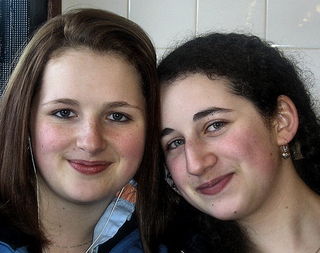Friends
Children's Growing Friendships
How children's understanding of friendship changes and develops with age.
Posted February 26, 2012 Reviewed by Devon Frye

Imagine one friendship between two preschoolers and another friendship between two high schoolers. In both cases, the kids probably have fun together, and they may be very fond of each other, but the older children are able to reflect on their relationship in a much more complex way than the little ones can.
Just as children usually crawl before they walk and walk before they run, they also show a developmental sequence in their friendships. Children of different ages think very differently about friendship. As they mature, they become better able to understand another person's perspective, which adds depth and meaning to their friendships.
Stages of Children's Friendships
Based on systematic interviews with children of different ages, psychologist Robert Selman offers a very useful 5-level framework for understanding developmental trends in children's friendships. Each of these levels is described below. [Note: I've taken the liberty of adding descriptive "quotes" for each level.] Try to figure out where your child currently is, developmentally.
Level 0 Friendship—Momentary Playmates: "I Want It My Way"
Approximate ages: 3-6 years
Children at this stage view friends as momentary playmates, and their friendships are all about having fun together. Their friends are kids who are conveniently nearby, and who do the same things they like to do.
Children at this stage have very limited ability to see other perspectives. They assume that other children think the same way they do, so they tend to get very upset when they find out that a playmate has a different opinion.
Children in the "I Want It My Way" stage like the idea of having friends, and they definitely have preferences for some peers over others, but they're not so good at being reliable friends. For instance, three-year-olds might say, "You're not my friend today!" if they just feel like doing something other than what their friend wants to do.
Despite the day-to-day or moment-to-moment variations in how friendly they act, preschoolers do show some continuity in their friendships. One study found that two-thirds of preschoolers who claimed each other as friends were still friends four to six months later.
Level 1 Friendship—One-Way Assistance: "What's In It For Me?"
Approximate ages: 5-9 years
At this level, children understand that friendship goes beyond whatever their current activity is, but they still think in very pragmatic terms. They define friends as children who do nice things for them—such as sharing a treat, saving them a seat on the bus, or giving them nice presents—but they don't really think about what they themselves contribute to the friendship.
Children at this level care a lot about friendship. They may even put up with a not-so-nice friend, just so they can have a friend. They also may try to use friendship as a bargaining chip, saying things like, "I'll be your friend if you do this!" or "I won't be your friend if you do that!"
Level 2 Friendship—Two-Way, Fair Weather Cooperation: "By the Rules"
Approximate ages: 7-12 years
Seven- to twelve-year-old children are able to consider a friend's perspective in addition to their own, but not at the same time. So what this means is that they understand turn taking, but they can't really step back and get an observer's perspective that would allow them to see patterns of interaction in their relationships.
At this stage, children are very concerned about fairness and reciprocity, but they think about these in a very rigid, quid pro quo way. So, if they do something nice for a friend, they expect that friend to do something nice for them at the next opportunity. If this doesn't happen, the friendship is likely to fall apart.
Children in the "By the Rules" stage tend to be very judgmental of both themselves and others. They evaluate themselves harshly, the way they think other people do. So, they say things like, "No one will like me because of my stupid haircut!" They tend to be jealous, and they're very concerned with fitting in by being exactly the same as everyone else.
Children at this stage often invent "secret clubs." These involve elaborate rules and lots of discussion about who is or isn't included as a member, but they tend to be short-lived.
Level 3 Friendship—Intimate, Mutually Shared Relationships: "Caring and Sharing"
Approximate ages: 8-15 years
At this stage, friends help each other solve problems and confide thoughts and feelings that they don't share with anyone else. They know how to compromise, and they do kind things for each other without "keeping score," because they genuinely care about each other's happiness.
For some children, this is also the "Joined at the Hip" stage. Girls, more often than boys, may be best friends and expect each other to do everything together. They feel deeply betrayed if a best friend chooses to be with another child.
Level 4 Friendship—Mature Friendship: "Friends Through Thick and Thin"
Approximate ages: 12 years and up
At this stage, children place a high value on emotional closeness with friends. They can accept and even appreciate differences between themselves and their friends. They're also not as possessive, so they're less likely to feel threatened if their friends have other relationships. Mature friendship emphasizes trust and support and remaining close over time, despite separations.

Selman originally proposed that later levels replace earlier ways of thinking, but it's probably more accurate to say that the more mature levels expand upon earlier perspectives, adding new and deeper layers of understanding. As adults, we value deeply intimate, on-going relationships, but we also like to have fun with our friends, and we appreciate it if they do nice things for us. We also have different kinds of relationships, including both close and casual friends.
Some researchers have criticized Selman's friendship framework because it's based on interviews, so it's limited by what children can tell us. If we observe what children actually do in social situations, it's clear that friendships don't just burst out of nowhere at the age of three.
- Children as young as six months get excited about seeing a peer. They smile and make noises to try to get the other baby's attention, and they might even crawl over to get close to a peer, but they tend to treat peers as toys to explore.
- Twelve to 18-month old toddlers show noticeable preferences for certain peers. They can play simple games like imitating each other or peek-a-boo, which shows that they have at least some rudimentary ability to understand another person's perspective.
- Two- and three-year-olds can sometimes be touchingly kind to each other. For example, if they see a friend crying, they might try to comfort that friend by offering a special blanket. This shows that very young children aren't all about self-interest.
Despite these criticisms, Selman's framework vividly illustrates an important point: Children are not just short adults. The way they think about relationships is qualitatively different at different ages, and it gets progressively more complex.
Selman's framework also illustrates that some kinds of "bad" social behavior are typical at certain ages. This doesn't mean that we should just accept it when children are unkind to each other. It does mean that we need to see social problems in a developmental context. We're better equipped to respond in compassionate and helpful ways if we realize that children's social missteps usually stem from immaturity and limited understanding rather than enduring character flaws.
Did you have a close friendship as a child that grew and continued into adulthood?
Related Posts
Growing Friendships blog posts are for general educational purposes only. They may or may not be relevant for your particular situation. You’re welcome to link to this post, but please don’t reproduce it without written permission from the author.
References
Gershman, E. S., & Hayes, D. S. (1983). Differential stability of reciprocal friendships and unilateral relationships among preschool children. Merrill-Palmer Quarterly: Journal of Developmental Psychology, 29, 169-177.
Hay, D. F., Payne, A., & Chadwick, A. (2004). Peer relations in childhood. Journal of Child Psychology and Psychiatry, 45, 84-108.
Kostelnik, M., Gregory, K. M., Soderman, A. K., & Whiren, A. P. (2012). Guiding children's social development and learning, 7th Ed.. Belmont, CA: Wadsworth.
Rubin, K. H. & Peplar, D. J. (1980). The relationship of child's play to social-cognitive growth and development. In H. C. Foot, A. J. Chapman, & J. R. Smith (Eds.), Friendship and social relations in children (pp. 209-233). Piscataway, NJ, US: Transaction Publishers.
Selman, R. L. (1981). The child as friendship philosopher. In S. R. Asher, and J. M. Gottman (Eds.), The Development of Children's Friendships. Cambridge: Cambridge University Press (pp.242-272).
Selman , R. L. (1980). The Growth of Interpersonal Understanding: Developmental and Clinical Analyses. Academic Press: New York.




